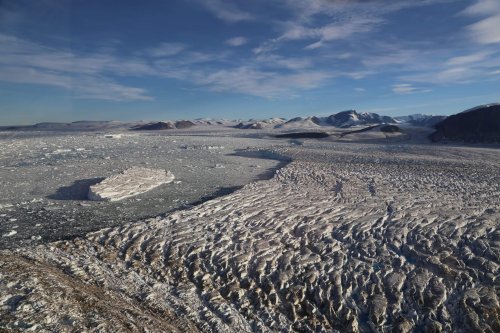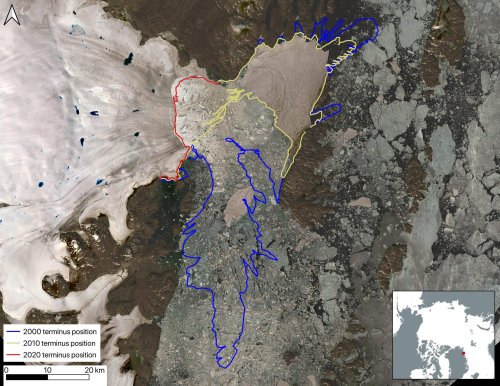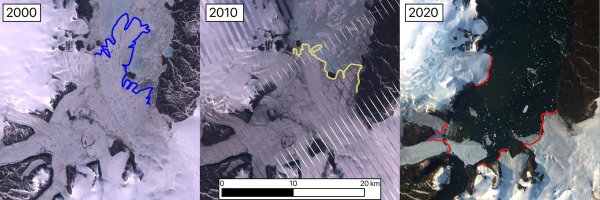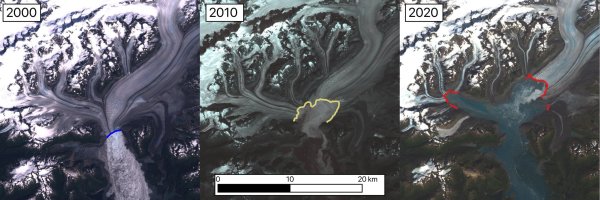
Le retrait des glaciers arctiques qui se terminent dans l’océan depuis 2000
– Par Will Kochtitzky et Luke Copland –
L’interface glacier-océan est un élément dynamique des systèmes de glaciers et de fjords. Tous les glaciers, qu’ils soient terrestres ou marins, perdent de la masse en raison de la fonte, mais ceux qui se terminent dans l’océan en perdent aussi en raison du vêlage des icebergs. Les courants océaniques peuvent apporter de l’eau chaude et accélérer le retrait des glaciers qui se terminent dans l’océan, tandis que les glaciers peuvent apporter à l’océan des eaux de fonte riches en nutriments et augmenter localement la productivité biologique. Même si cette interface a fait l’objet d’une grande attention de la part des glaciologues et des océanographes, les estimations du changement de position des glaciers à terminaison marine n’avaient jamais été complétées qu’à des échelles locales ou régionales, en utilisant des méthodes parfois incohérentes. Il en résulte des lacunes dans la compréhension des impacts du changement climatique sur les environnements nordiques, des lacunes dans les rapports d’évaluation du climat et un manque de connaissances sur les facteurs à l’origine des changements de glaciers dans l’Arctique.
Nous avons donc rassemblé des images satellites complètes de tous les glaciers à terminaison marine de l’hémisphère nord pour les années 2000, 2010 et 2020, et cartographié les changements de leur étendue terminale en numérisant manuellement la position frontale de chaque glacier pour chaque année. Cela nous a permis de quantifier, pour la toute première fois, l’emplacement de chaque glacier qui se termine dans l’océan dans l’hémisphère nord, et de mesurer les changements de superficie de ces glaciers. Nous avons recensé un total de 1 704 glaciers se terminant dans l’océan en 2000, dont 123 se sont retirés de l’océan et se sont terminés sur terre en 2020. Dans l’ensemble, nous avons constaté que 85 % des glaciers se terminant en mer ont reculé, tandis que seulement 2,5 % ont avancé. La superficie totale des glaciers a diminué en moyenne d’un peu plus de 1 km2 par jour au cours des 20 dernières années, pour une perte totale de 7 527 ±31 km2 entre 2000 et 2020. À l’échelle de l’hémisphère, les pertes sont principalement attribuables à la diminution du bilan de masse des glaciers en raison du réchauffement climatique et à l’adaptation des glaciers à cette nouvelle normalité.
Comme le climat continue de se réchauffer dans l’Arctique et que les glaciers continuent d’avoir un bilan de masse négatif, nous nous attendons à ce que le retrait des terminaisons des glaciers se poursuive pendant les décennies à venir. De nombreuses plates-formes de glace ont déjà disparu et il est peu probable qu’elles se reconstituent. Il reste quelques plates-formes de glace, principalement le long de l’océan Arctique, dans l’extrême nord de l’Arctique, au Canada et au Groenland, ainsi qu’à la terre François-Joseph, en Russie, dont beaucoup risquent de disparaître au cours des prochaines décennies. De nouvelles poussées se produiront et entraîneront quelques avancées spectaculaires, bien que ces événements soient actuellement difficiles à prévoir. De même, certaines des avancées les plus importantes de la dernière décennie, attribuables aux poussées, entraîneront certains des retraits les plus importants, car ces glaciers entrent dans leur phase de quiescence.
Nous décrivons plus en détail ces changements dans notre récent article intitulé « Retreat of Northern Hemisphere marine-terminating glaciers, 2000-2020 ».
The retreat of Arctic glaciers that end in the ocean since 2000
– By Will Kochtitzky –
The glacier-ocean interface is a dynamic part of glacier and fjord systems. All glaciers, both land and marine-terminating, lose mass due to melt, but those that end in the ocean also lose mass by the calving of icebergs (Figure 1). Ocean currents can bring warm water and accelerate the retreat of glaciers that end in the ocean, while glaciers can bring nutrient rich meltwater to the ocean and locally increase biological productivity. Even though this interface has received much attention from glaciologists and oceanographers, estimates of marine-terminating glacier position change had only ever been completed on local or regional scales (e.g., Carr et al., 2017; Cook et al., 2019; McNabb et al., 2015), using sometimes inconsistent methods. This has resulted in gaps in understanding the impacts of climate change on northern environments, gaps in climate assessment reports, and a lack of knowledge of the factors driving glacier changes across the Arctic.

We therefore gathered comprehensive satellite imagery of all marine-terminating glaciers across the northern hemisphere from 2000, 2010 and 2020, and mapped changes in their terminus extent by manually digitizing each glacier’s frontal position for each year. This has enabled us to quantify, for the first time, the location of every glacier that ends in the ocean in the northern hemisphere, and measure the area changes of these glaciers. We found a total of 1704 glaciers ending in the ocean in 2000, of which 123 had retreated out of the ocean and terminated on land by 2020. Overall, we found that 85% of marine-terminating glaciers retreated while only 2.5% advanced, with the total area of glaciers reducing by an average of just over 1 km2 per day for the past 20 years, for a total loss of 7527 ± 31 km2 between 2000 and 2020. That is equivalent to 6.6 times the area of Manhattan lost annually. On a hemispheric basis, losses are primarily a consequence of declining glacier mass balance due to a warming climate and glaciers adjusting to this new normal.

To better understand local and regional changes, we individually examined the glaciers that are changing the fastest. The biggest changes are occurring at glaciers with unique characteristics that can enhance the impacts of changes in glacier mass balance, including ice shelves, surge-type glaciers, those with an unstable basal geometry where the bed gets deeper with distance inland, and those with a particularly wide margin in contact with the ocean. A few dozen ice shelves, or parts of a glacier floating on the ocean, were lost in the last 20 years, including Zachariae Isstrøm (NE Greenland; Figure 2), Matusevich (Arctic Russia; Figure 3), and Petersen (Arctic Canada). Ice shelves are particularly sensitive to changes because they are susceptible to changes in both the atmosphere and ocean. Other glaciers with an unstable basal topography that contributed to their rapid retreat include Humboldt Glacier (NW Greenland) and Columbia Glacier (Alaska; Figure 4). While previous work has specifically described these two glaciers as having unstable basal geometries due to their deepening inland, it is likely that other glaciers in the northern hemisphere are similar but have received less attention due to lack of ice thickness measurements.
Glaciers that display periodic instabilities, or surge events, are unique because they are both mostly responsible for the few advancing glaciers that we observed in the last 20 years, as well as some of the biggest retreats. These glaciers are unique because they move relatively slowly for years to decades, but then rapidly advance for months to years. In contrast, most glaciers flow at approximately the same speed between one year and the next. When surge events occur, they typically cause the glacier velocity to increase by at least an order of magnitude and can result in kilometers of terminus advance. The biggest advances occurred on Northostbreen Glacier (~14 km advance; Svalbard), Vavilov Ice Cap (~11 km advance; Arctic Russia), and Basin-3 of Austfonna (~5 km advance; Svalbard). However, there were many glaciers that surged in the 20th century that have now returned to a period of relative quiescence and have displayed rapid retreats such as Stonebreen (~4 km retreat) and Braasvellbreen (~2 km retreat) in Svalbard. We fully expect the glaciers that advanced the most in recent decades will be among those that retreat the most in coming decades.

Finally, there is a group of glaciers that have an unusually wide calving margin, where there is a large proportion of their area in contact with the ocean, meaning that a small distance of retreat is magnified by the width of the glacier. Many of these glaciers have calving termini that are over 15 km wide, which puts them in the 97th percentile among all glaciers that end in the ocean in the northern hemisphere. These glaciers are likely to continue retreating in coming decades at a high rate.

As the climate continues to warm in the Arctic, and glaciers continue to have a negative mass balance, we expect that retreat of these termini will continue for decades to come. Many ice shelves have already been lost and are unlikely to reform. There are a few remaining ice shelves, mostly along the Arctic Ocean, in far northern Arctic Canada and Greenland, as well as Franz Josef Land, Russia, many of which are likely to be lost in the coming decades. New surge events will occur and lead to a few spectacular advances, although these events are currently difficult to predict. Similarly, some of the biggest advances of the last decade due to surging will lead to some of the biggest retreats, as these glaciers enter their quiescent phase.
We further describe these changes in our recent article titled “Retreat of Northern Hemisphere marine-terminating glaciers, 2000-2020”.
Will Kochtitzky is a PhD candidate in the Department of Geography, Environment and Geomatics at the University of Ottawa. His recent research has focused on describing the area and volume changes of marine-terminating glaciers since 2000 to inform glacier mass balance and modeling studies and improve estimate of sea level rise. Will received his B.S. from Dickinson College before going to the University of Maine for his M.S. Will’s broad research interests are in combining field and satellite observations to better understand glacier change around the world.
Luke Copland is a Professor in the Department of Geography, Environment and Geomatics at the University of Ottawa, and holds the University Research Chair in Glaciology. He directs the Laboratory for Cryospheric Research, and his research program is focused on understanding the dynamics and recent changes of glaciers, ice caps and ice shelves across northern Canada, including in the St. Elias Mountains, Yukon, and the Queen Elizabeth Islands, Nunavut.